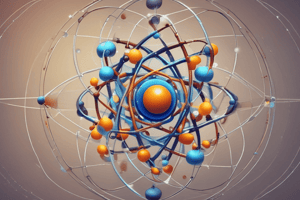Podcast
Questions and Answers
What is the formula to obtain the unit of N?
What is the formula to obtain the unit of N?
- N = 1/2 k z2 (correct)
- N = k z + z
- N = k z + 1/2
- N = k z2 / 2
In SI writing style, how should the unit of pressure, Pascal, be symbolized?
In SI writing style, how should the unit of pressure, Pascal, be symbolized?
- pa
- Pa (correct)
- Pasc
- PA
Which prefix represents $10^{-9}$ in metric units?
Which prefix represents $10^{-9}$ in metric units?
- nano (correct)
- pico
- milli
- micro
How should numbers be separated from their unit of measurement in SI writing style?
How should numbers be separated from their unit of measurement in SI writing style?
What is the primary goal of physics?
What is the primary goal of physics?
In the metric system, which unit is used to measure mass?
In the metric system, which unit is used to measure mass?
What is the derived unit for density?
What is the derived unit for density?
How is speed defined in physics?
How is speed defined in physics?
Which of the following statements about physical theories is true?
Which of the following statements about physical theories is true?
What is the correct unit to measure temperature in the SI system?
What is the correct unit to measure temperature in the SI system?
Acceleration is defined as which of the following?
Acceleration is defined as which of the following?
What does the derived unit for area represent?
What does the derived unit for area represent?
Flashcards
Unit of Energy (N)
Unit of Energy (N)
The unit of energy in the equation N = 1/2 * k * z^2 depends on the units of mass (k) and speed (z).
SI Unit Symbols
SI Unit Symbols
Symbols for units are lowercase, except for those named after people. Units are separated from numbers by a space (e.g., 2.21 kg).
Metric Prefixes
Metric Prefixes
Prefixes (like kilo, milli, micro) are used to represent powers of 10 with units.
SI Writing Style
SI Writing Style
Signup and view all the flashcards
Physical Theory
Physical Theory
Signup and view all the flashcards
Metric System (m.k.s)
Metric System (m.k.s)
Signup and view all the flashcards
Derived Unit
Derived Unit
Signup and view all the flashcards
SI Base Units
SI Base Units
Signup and view all the flashcards
Area
Area
Signup and view all the flashcards
Volume
Volume
Signup and view all the flashcards
Density
Density
Signup and view all the flashcards
Speed
Speed
Signup and view all the flashcards
Acceleration
Acceleration
Signup and view all the flashcards
Study Notes
Chapter One: Basic Concepts
- Physics aims to understand the physical world through theories based on experiments.
- A physical theory is a proposed explanation, often mathematical, for how a system functions.
- Theories make predictions that can be tested through observation and experimentation.
- All theories are provisional, as they might need adjustments based on new findings.
- No theory fully explains all physical phenomena even within a specific field.
- Theories are continually refined as knowledge expands.
The Metric System (m.k.s.)
- Length is measured in meters.
- Mass is measured in kilograms.
- Time is measured in seconds.
The Centi-metric System (c.g.s.)
- Length is measured in centimeters.
- Mass is measured in grams.
- Time is measured in seconds.
SI Base Units
- A table listing the SI base units, their names, and abbreviations. (Refer to the provided table for details).
Derived Units
- Derived units are built from fundamental units.
- Examples include area (length x length) with units like m², cm², km².
- Examples include volume (length x length x length) with units like m³, cm³, km³.
- Density is mass per unit volume (M/V), with units like kg/m³, g/cm³.
Other Derived Units
- Speed is the rate of change of distance with time (distance/time).
- Units include m/s, km/s, mile/hour.
- Acceleration is the rate of change of speed with time (speed/time).
- Units include m/s², km/s², km/h².
Classwork Example
- A sample calculation (N = 1/2 k z²) is provided for obtaining the unit of N (or possibly a related variable like energy).
- Relevant variables (N, K, z) are identified (energy, mass, speed).
Prefixes for Powers of Ten
- A table listing prefixes for powers of ten used with SI and c.g.s units is provided (refer to the table for details).
SI Writing Style
- Symbols are lowercase, except those derived from names (e.g., Pa for Pascal).
Writing Conventions
- A space should separate numbers and unit symbols (e.g., "2.21 kg").
- Exceptions for symbols like angular degrees, minutes, and seconds are specified in the text (°, ' and "").
- Spaces may be used in grouping decimal digits in sets of three (e.g., 1 000 000).
Studying That Suits You
Use AI to generate personalized quizzes and flashcards to suit your learning preferences.




